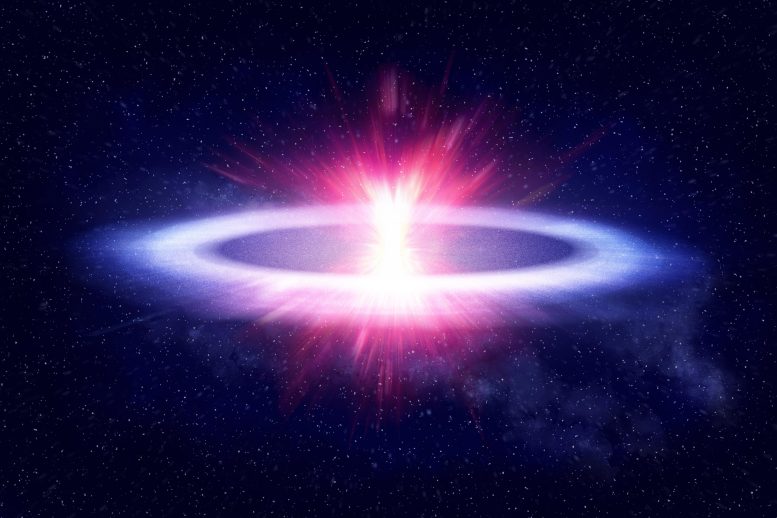
Slim Boom. Credit: Phil Drury, University of Sheffield
Astronomers have observed an explosion 180 million light-years away that challenges our current understanding of cosmic explosions, exhibiting a significantly flatter appearance than previously thought possible.
- Astronomers have observed an explosion 180 million light years away which challenges our current understanding of explosions in space, that appeared much flatter than ever thought possible
- Explosions are almost always expected to be spherical, as the stars themselves are spherical, but this one is the flattest ever seen
- The explosion observed was an extremely rare Fast Blue Optical Transient (FBOT) — known colloquially amongst astronomers as “the cow” — only four others have ever been seen, and scientists don’t know how they occur, but this discovery has helped solve part of the puzzle
- A potential explanation for how this explosion occurred is that the star itself may have been surrounded by a dense disk or it may have been a failed supernova
An explosion the size of our solar system has baffled scientists, as part of its shape — similar to that of an extremely flat disc — challenges everything we know about explosions in space.
The explosion observed was a bright Fast Blue Optical Transient (FBOT) — an extremely rare class of explosion that is much less common than other explosions, such as supernovas. The first bright FBOT was discovered in 2018 and given the nickname “the cow.”
Explosions of stars in the universe are almost always spherical in shape, as the stars themselves are spherical. However, this explosion, which occurred 180 million light-years away, is the most aspherical ever seen in space, with a shape like a disc emerging a few days after it was discovered. This section of the explosion may have come from material shed by the star just before it exploded.
It’s still unclear how bright FBOT explosions occur, but it’s hoped that this observation, published recently in the journal Monthly Notices of the Royal Astronomical Society, will bring us closer to understanding them.
Dr. Justyn Maund, Lead Author of the study from the University of Sheffield’s Department of Physics and Astronomy, said: “Very little is known about FBOT explosions — they just don’t behave like exploding stars should, they are too bright and they evolve too quickly. Put simply, they are weird, and this new observation makes them even weirder.
“Hopefully this new finding will help us shed a bit more light on them — we never thought that explosions could be this aspherical. There are a few potential explanations for it: the stars involved may have created a disc just before they died or these could be failed supernovas, where the core of the star collapses into a black hole or neutron star which then eats the rest of the star.
“What we now know for sure is that the levels of asymmetry recorded are a key part of understanding these mysterious explosions, and it challenges our preconceptions of how stars might explode in the Universe.”
Scientists made the discovery after spotting a flash of polarized light completely by chance. They were able to measure the polarization of the blast — using the astronomical equivalent of polaroid sunglasses — with the Liverpool Telescope (owned by Liverpool John Moores University) located on La Palma.
By measuring the polarisation, it allowed them to measure the shape of the explosion, effectively seeing something the size of our Solar System but in a galaxy 180 million light years away. They were then able to use the data to reconstruct the 3D shape of the explosion, and were able to map the edges of the blast — allowing them to see just how flat it was.
The mirror of the Liverpool Telescope is only 2.0m in diameter, but by studying the polarization the astronomers were able to reconstruct the shape of the explosion as if the telescope had a diameter of about 750km.
Researchers will now undertake a new survey with the international Vera Rubin Observatory in Chile, which is expected to help discover more FBOTs and further understand them.
Reference: “A flash of polarized optical light points to an aspherical ‘cow’” by Justyn R Maund, Peter A Höflich, Iain A Steele, Yi Yang, Klaas Wiersema, Shiho Kobayashi, Nuria Jordana-Mitjans, Carole Mundell, Andreja Gomboc, Cristiano Guidorzi and Robert J Smith, 21 February 2023, Monthly Notices of the Royal Astronomical Society.
DOI: 10.1093/mnras/stad539

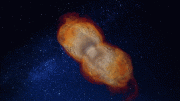
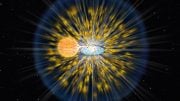
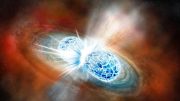
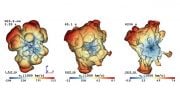
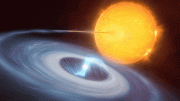
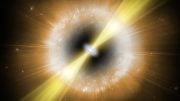
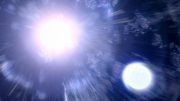
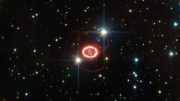
The darlings are baffled by the moo-moos. They might have grown up on the farm. The AD blitz has arrived, and it really cuts into one’s focus — yours and us readers. Not very atmospheric at all. More like a monsoonl.
Maybe a spinning degenerate spherical mass could be replaced with a circular ribbon-like mass providing a seed for star formation. Haven’t thought about it too much.
It resembles what I suppose the collapse of a graviton should look like in form, a field that pulls along one axis and pushes along the others. It’s opposite to the energy in the butterfly nebula’s configuration, which itself thus resembles an anti-graviton effect.
Gravitons are elementary particles – they don’t collapse, and their antiparticles are another graviton.
Could the star have been a rapidly rotating star where the collapse begins at the poles, and the rotation causes the equator of the star to expand outward at a greater speed resulting in the flat shape?
Yes. “The early behaviour of the lightcurve favours the presence of a circumstellar medium that, unlike a massive envelope, is spatially confined with a limited radial extent (Ho et al. 2019) or is not spherically symmetric. … The presence of such pre-existing disk-like material is also a feature for a number of models for the origin of AT 2018cow and luminous FBOTs, such as: the Common Envelope Jets Supernova (Soker 2022), a merger between a Wolf-Rayet star and a black hole (Metzger 2022) and the merger of two white dwarfs (Lyutikov & Toonen 2019).”
I thought the shape of the Universe was FLAT. I keep reading that over and over and over despite the notion the Universe was created by a big bang explosion. I guess that explosion wasn’t even close to spherical either or we wouldn’t be FLAT. You can tell we’re flat too because everything only moves in two dimensions. There’s no depth. That’s how we know our universe is actually FLATLAND. We’re a 3D projection of a 2D universe and time doesn’t exist. We just think it does because we’re reading “the book” in a certain order making it appear so. In reality, there is no time. There is no space. There is no matter. There is only ME (Mind-Energy). And ME is dreaming about this utter nonsense about flat explosions, flat universes and flat tires.
The average flatness of 3D space is observed and has nothing to do with the number of spatial dimensions but the absence of (on average) general relativistic space curvature.
Nor has it to do with space expansion by the time the universe enters the hot big bang era. (And the question if the previous inflation flattened space or happened in a spatially infinite space is an open question.) Space expansion is that results in the modern universe and its content, the “primordial atom” early models were abandoned a century ago because they don’t work. (The universe is too smooth at 1 part in 100,000 to be caused by anything else than a uniform expansion, the ‘big bang explosion creation’ would be uneven at “1 part in 1”.)
ME, whatever that means, comes over as utter nonsense. Especially you don’t quantify anything that we can see. This is done in science and is why science is useful for building tools and understanding how things work.
The paper speculates in a pre-existing disk-like material.
In any case, the COW disk height is < 10 % of the diameter.